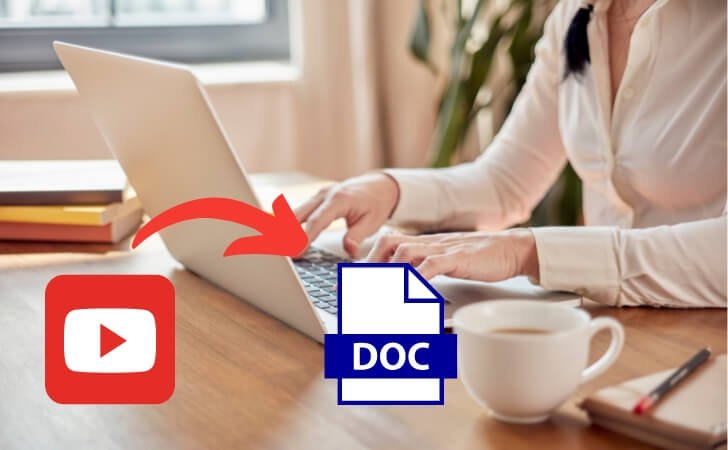AFFILIATE DISCLOSURE
This post may contain affiliate links. An affiliate means Escribr may earn referral fees if you make a purchase through our link without any extra cost to you. It helps to keep this blog afloat. Thanks for your support!
Did you know that by visiting this blog, you are doing good in the world? READ THIS.
Ever recorded a podcast, webinar, or video and thought about using it again?
Transcript repurposing is your answer.
This guide will teach you how to turn your transcripts into interesting blog posts for free.
Sarah, a small business owner, found it hard to keep her blog fresh.
She had lots of valuable recordings but didn’t know how to use them.
Then she learned about transcript repurposing.
With a few easy steps, Sarah made her old content new again and improved her online presence.

Key Takeaways
- Discover the benefits of repurposing your transcripts into blog posts
- Learn how to prepare your transcripts for easy repurposing
- Explore free and paid tools to streamline the repurposing process
- Gain step-by-step guidance on formatting and optimizing your repurposed blog posts
- Uncover tips and tricks to promote your new content effectively
Introduction to Repurposing Transcripts
Transcript repurposing turns your audio or video transcripts into new content formats.
It’s a smart way to use your work again and reach more people online.
What is Transcript Repurposing?
It’s about taking text from your recordings and making new content like blog posts or social media.
This way, you get fresh content without starting over.
Benefits of Repurposing Transcripts
Repurposing your transcripts boosts your content marketing.
It helps you make more content easily and keeps your schedule on track.
It also improves your search engine ranking and connects with your audience in new ways.
- Increased content output: Repurposing transcripts allows you to produce more content with less effort, helping you maintain a consistent publishing schedule.
- Improved search engine optimization (SEO): By converting your transcripts into blog posts, you can optimize the content for relevant keywords and improve your online visibility.
- Better audience engagement: Repurposed content, such as bite-sized social media updates or interactive infographics, can help you connect with your audience in new and engaging ways.
- Reduced content creation time: Repurposing transcripts streamlines the content creation process, allowing you to focus your time and resources on other essential marketing tasks.
With the many benefits of transcript repurposing, it’s no wonder that savvy content marketers are leveraging this strategy to amplify their reach and drive better results for their businesses.

Preparing Your Transcript for Repurposing
Before you can start repurposing your transcript, it’s crucial to ensure that your content is properly formatted and ready for the conversion process.
This section will guide you through the necessary steps to prepare your transcript.
You’ll learn how to clean up the text, organize the content, and ensure it’s in the right file format.
Let’s explore the key steps to prepare your transcript for repurposing:
- Clean up the text: Review your transcript and remove any unnecessary formatting. This includes excessive line breaks, unusual characters, or formatting inconsistencies. This will help ensure a clean, consistent document that’s easy to work with.
- Organize the content: Identify the key sections, topics, and talking points within your transcript. Organize the content in a logical flow. This makes it easier to repurpose into a blog post or other content format.
- Check the file format: Ensure your transcript is in a widely-accepted file format, such as TXT or Microsoft Word. This makes it easier to work with the content and transfer it to other platforms or tools.
By taking the time to prepare your transcript, you’ll set yourself up for a smoother and more successful repurposing process.
With a clean, organized, and properly formatted transcript, you’ll be well on your way to creating engaging and SEO-optimized content from your existing audio or video recordings.
“Proper preparation is the key to successful repurposing. Take the time to get your transcript in order, and you’ll be amazed at the content you can create.”

Tools for Repurposing Transcripts
There are many tools available for repurposing transcripts.
You can find free online options or paid software solutions.
The right tools can make the process easier and help you use your content well.
Free Online Tools
There are several free online tools to help you repurpose transcripts. Some popular ones include:
- Otter.ai – This AI tool transcribes audio and video files. It makes it easy to extract and use the text.
- Temi – A speech-to-text service that gives accurate transcriptions. You can export the text in different formats.
- Descript – A platform that transcribes your audio and offers editing tools. It helps you refine your repurposed content.
Paid Software Options
If you want a more advanced tool, there are paid software options. Here are a few to consider:
| Tool | Key Features | Pricing |
|---|---|---|
| Rev | Accurate transcription, captioning, and translation services | $1.25 per minute of audio |
| Sonix | AI-powered transcription, video editing, and repurposing tools | Starts at $10 per hour of audio |
| Happy Scribe | Transcription, translation, and collaboration features | Starts at $15 per hour of audio |
Choosing the right tools for repurposing transcripts can save you time.
It also improves the quality of your content, and it helps you make the most of your audio and video resources.
Step-by-Step Guide to Repurposing Transcripts
Formatting and Editing
Start by reviewing your transcript and picking out the main points.
Organize these into sections that are easy to follow.
This makes your content clear and simple.
Next, make the language smooth and engaging.
Remove any jargon that might confuse readers.
Use simple words and format the transcript for readability.
Add headings, bullet points, and short paragraphs to make it easy to scan.
Adding Visual Elements
Adding visuals can make your blog post more interesting.
Think about using images, infographics, or short video clips to enhance the content.
This can make the topic more engaging and alive.
Choose visuals that are high-quality and match your blog’s theme.
Make sure to include alt text and file names that help with search engine visibility.
- Review the transcript and identify key points, insights, and takeaways.
- Organize the content into a clear and logical structure.
- Refine the language, using conversational and accessible language.
- Format the content for readability, using headings, bullet points, and short paragraphs.
- Incorporate relevant visual elements, such as images and infographics.
- Optimize the visuals for search engine visibility.
“Incorporating visuals can significantly enhance the overall user experience and engagement of your repurposed blog post.”
Repurpose Transcript to a Blog Post Free
Turning your transcript into a great blog post is free.
We’ll look at tools and platforms that help you do this without spending money.
You can make a high-quality, engaging blog post for free.
Using free online text editors like Google Docs or Microsoft Word is easy.
Just copy and paste your transcript into these tools.
Then you can format and structure it into a clean, readable blog post.
You can also add headings, bullet points, and more to make your content look good.
You can also use free blogging platforms like WordPress.com or Blogger.com to create a blog.
These platforms are easy to use and offer free templates and themes.
They help you present your blog post in a visually appealing way.
Choosing a free tool or platform is important.
The goal is to create a well-structured, engaging, and informative blog post.
By repurposing your transcript for free, you can refresh your content and reach more people without spending money.
“Repurposing your transcript into a blog post is a game-changer. It allows you to maximize the value of your content and reach a wider audience, all without breaking the bank.”
Optimizing Your Repurposed Blog Post
After turning your transcript into a blog post, it’s time to make it search-friendly and engaging.
Use SEO tips to increase your content’s reach and impact.
This way, more people can find and enjoy your work online.
Keyword Research and Implementation
Start by finding the right keywords for your blog post.
Look for terms your audience might search for.
Use these keywords in your title, headings, and body, but keep your writing natural.
Optimizing Meta Tags and Structured Data
Make sure your meta title, description, and header tags (H1, H2, H3) match your content.
They should include your target keywords.
Also, add structured data like schema markup to help search engines understand your post better.
Enhancing Content Structure and Readability
Organize your blog post with clear headings and subheadings.
Use images or infographics to enhance your text.
Write in a friendly, straightforward way to engage your readers.
By applying these SEO tips, you can optimize your repurposed blog post, improve the SEO of your repurposed content, and maximize the visibility and impact of your repurposed work.
Make the most of your transcript repurposing and share your insights with more people.
Promoting Your Repurposed Blog Post
Congratulations! You’ve turned your transcript into a great blog post.
Now, it’s time to share it with your audience.
Promoting your post well is key to getting more views and engagement. Here are some effective ways to do it:
Leverage Social Media
Social media is a strong tool for sharing your content.
Post your blog on sites like LinkedIn, Twitter, and Facebook.
Talk to your followers, answer their questions, and ask them to share your post.
Utilize Email Marketing
Email marketing is great for reaching people you already know.
Send out a newsletter that includes your blog post and other valuable content.
Ask your subscribers to read and share your post.
Optimize for Search Engines
Make sure your blog post is easy for search engines to find.
Use the right keywords, meta tags, and descriptions.
This will help your post show up higher in search results, making it easier for people to find.
Collaborate with Influencers
Try to work with influencers, experts, or brands in your field.
See if they want to share your blog post on their platforms.
This can help you reach new people and get your content seen by more.
Utilize Paid Advertising
Think about using paid ads, like social media ads or search engine marketing.
This can help you get your post seen by more people. Make sure to target your ads well and keep an eye on how they’re doing.
Remember, promoting your blog post is an ongoing job.
Try different methods, see what works, and keep improving.
This way, you’ll make sure your content reaches the right people and meets your marketing goals.
Tips and Tricks for Effective Repurposing
Turning transcripts into blog posts can change your content game.
But it’s key to work smart to save time and resources.
We’ll share tips, tricks, and hacks to make your transcript repurposing smoother and more effective.
Time-Saving Hacks for Repurposing Transcripts
Repurposing transcripts well isn’t just about the outcome. It’s also about making the process quicker.
Here are some hacks to save you time:
- Leverage automation tools: Use AI tools to automate tasks like transcription and formatting. This cuts down on manual work.
- Batch your workflows: Work on several transcripts at once. This keeps you focused and boosts your efficiency.
- Streamline your editing process: Create a standard editing checklist. It saves time on formatting and polishing.
By using these hacks, you can make high-quality blog posts faster. This lets you spend more time on other content strategy tasks.
“Repurposing transcripts is a powerful way to maximize the value of your content, but it’s important to work smart, not just hard. These time-saving hacks can help you streamline the process and unlock the full potential of your repurposed blog posts.”
Common Pitfalls and How to Avoid Them
Turning transcripts into blog posts is a smart content move, but it comes with its own set of challenges.
Knowing how to sidestep common pitfalls is key to making your repurposed content a hit.
One big mistake is bad formatting.
If your blog post looks messy with no clear headings or paragraphs, readers will struggle to follow.
Also, forgetting to make your content search engine friendly can hurt its visibility.
Another issue is not promoting your content well enough.
Just posting it online and hoping for the best is not enough.
You need to share it on social media, in emails, and other places where your audience hangs out.
- Make sure your repurposed content is easy to read and looks good.
- Use keywords and meta tags to help search engines find your post.
- Have a solid plan to share your content with your audience.
- Avoid mistakes like bad formatting, poor optimization, and weak promotion.
- By fixing these issues, you can make your repurposed content more effective and reach your goals.
| Common Mistake | Solution |
|---|---|
| Poor Formatting | Use clear headings, subheadings, and paragraphs to structure your content. |
| Lack of Optimization | Incorporate relevant keywords and meta tags to improve SEO. |
| Ineffective Promotion | Develop a comprehensive promotional strategy to reach your target audience. |
By tackling these common issues in repurposing transcripts, you can make engaging, SEO-friendly, and well-promoted blog posts. These posts will offer real value to your readers and help you meet your content marketing goals.
“Repurposing transcripts can be a powerful content strategy, but it’s crucial to avoid the common pitfalls that can undermine its effectiveness.”
Future of Transcript Repurposing
The digital world is changing fast, and transcript repurposing is set for a big change.
New trends and technologies are changing how we make and share content.
This opens up new chances for businesses and content makers.
One big change is the push for personalized content experiences.
People want content that fits their interests and needs.
Transcript repurposing will help make this happen by turning audio and video into tailored blog posts and social media.
The rise of voice-based interactions is another trend. Smart speakers and virtual assistants are becoming common.
Transcript repurposing will help make content that works well with voice commands, keeping businesses relevant.
Also, artificial intelligence (AI) and machine learning will change how we repurpose transcripts.
New tools will make the process faster and better, helping businesses use their content more effectively.
As transcript repurposing evolves, content makers and businesses need to keep up.
By using new trends and technologies, they can make their content more engaging.
This will help them connect with their audience better, now and in the future.
The future of transcript repurposing is exciting and full of new chances.
Wrap-Up
We hope you’ve learned a lot about turning transcripts into engaging blog posts.
This guide is designed to help you create more content, boost your online presence, and connect better with your audience.
You now know the perks of repurposing transcripts, the tools to make it easier, and how to make your blog posts stand out.
Making your audio or video transcripts into exciting written content is now easier than ever.
The secret to great transcript repurposing is to make your blog posts informative, interesting, and easy on the eyes.
Use repurposing to make the most of your content.
This will help you get more people involved, build loyalty, and reach your marketing targets.
FAQ
What is Transcript Repurposing?
Transcript repurposing turns your audio or video transcripts into new content. This can be blog posts. It helps you use your content in new ways, making it more engaging and shareable.
What are the Benefits of Repurposing Transcripts?
Repurposing your transcripts has many benefits. It boosts your content output and SEO. It also improves audience engagement and makes content creation more efficient.
How Do I Prepare My Transcript for Repurposing?
Before you start, make sure your transcript is ready. Clean up the text, organize it, and check the file format.
What Tools Can I Use to Repurpose Transcripts?
Many tools can help you repurpose your transcripts. Free online tools and paid software are available. They make formatting, editing, and enhancing easier.
How Do I Repurpose a Transcript into a Blog Post?
To turn a transcript into a blog post, start by formatting and editing the text. Add visuals and optimize it for search engines and your audience.
How Can I Repurpose a Transcript to a Blog Post for Free?
You can repurpose a transcript into a blog post for free. Use free online tools and platforms to create high-quality content without spending money.
How Can I Optimize My Repurposed Blog Post?
To optimize your blog post, focus on SEO. Do keyword research, optimize meta tags, and structure your content well. This improves visibility and engagement.
How Can I Promote My Repurposed Blog Post?
Promote your blog post through social media, email marketing, and other digital channels. This helps reach more people and increase traffic.
Where Can I Find Real-World Examples and Case Studies of Successful Transcript Repurposing?
This guide will share examples and case studies of successful transcript repurposing. Learn from others and discover effective strategies.
What Tips and Tricks Can Help Me Repurpose Transcripts More Effectively?
This guide offers tips, tricks, and hacks for efficient transcript repurposing. Learn how to streamline your workflow and maximize your content’s impact.
What Are the Common Pitfalls in Transcript Repurposing, and How Can I Avoid Them?
This guide will cover common pitfalls in transcript repurposing. Learn how to avoid formatting issues, lack of optimization, and poor promotion. Get practical solutions for success.
What Is the Future of Transcript Repurposing?
The future of transcript repurposing is changing with technology and content habits. This guide will explore trends and how to stay ahead. Learn to adapt your strategies for your audience’s evolving needs.











